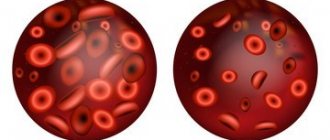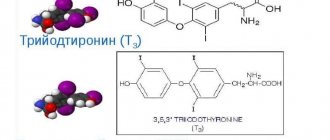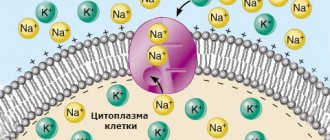Hematocrit is reduced: what does this mean?
Let's start with what is hematocrit?
This is a conditional indicator that is derived by determining the ratio of the number of formed particles - platelets, leukocytes and erythrocytes to the total amount of blood in the venous and arterial vessels.
The overwhelming number of particles are erythrocytes, therefore it is generally accepted that hematocrit (Hst) is an indicator of the number of erythrocytes to the volume of blood (it is calculated in liters).
Now about red blood cells: the duties of these blood particles include delivering oxygen to the blood and removing carbon dioxide from it. A certain (normal) number of them copes with this task. Accordingly, if there are fewer red blood cells, then the hematocrit will be reduced, which means that various pathologies may develop.
For this reason, this topic requires special attention and careful study, since there can be many reasons for the decline. To determine its level, special laboratory tests are prescribed, diagnostics are carried out, using the results of which a diagnosis is made.
How is a blood test performed?
What does hematocrit mean?
Human blood consists of plasma and formed elements. 98% of the liquid part is water, 2% are proteins and electrolytes. The blood cell mass includes red blood cells, white blood cells and platelets. To determine hematocrit, you need to correlate two values - the total volume of blood and the volume of all cells. 99% of them are red cells (erythrocytes). Sometimes the indicator is calculated taking into account only their volume, and not all cells. There are no significant differences between the results.
Hematocrit reflects the percentage of total blood that is occupied by red blood cells. The indicator is important for:
- doctors making decisions on emergency treatment measures;
- monitoring therapy for anemia or polycythemia;
- assessing the patient’s general condition (risk of blood clots, hypoxia).
A general blood test, and therefore hematocrit, is checked in almost all patients in clinics, since this is the simplest and most accessible way to comprehensively assess the patient’s health status. The doctor especially pays special attention to hematocrit if the patient:
- burns;
- varicose veins;
- atherosclerosis;
- diseases of the cardiovascular system;
- damage to the liver (cirrhosis, steatohepatosis, etc.), kidneys, pancreas (pancreatitis, etc.);
- endocrine disorders;
- There are suspicions of pathologies of the blood and hematopoietic organs.
How to determine
In modern laboratories, the hematocrit number is calculated using automatic equipment (hemoanalyzer). The old method is considered to be a method based on centrifugation. A graduated tube (called a hematocrit) filled with blood is placed in a centrifuge. Under the influence of centrifugal force, the biomaterial is divided into 2 fractions - plasma and erythrocyte mass. Their ratio can be assessed even visually. By calibration, an accurate calculation of hematocrit is carried out.
What are normal hematocrit indicators for men and women, as well as children?
To discuss the topic of reduced indicators, you must first understand the normal indicators.
The average Hst level is 0.45 l/liter (450 ml) - this accounts for 40-45 percent of the total blood volume.
But the average percentage differs from the norm for men, women and children, and also depends on their age.
- In children:
- Newborns - 44-62%,
- Grudnichkov - 36-44%,
- From 2 to 5 years – 32-41%,
- From 6 to 11 years – 33-44%.
- In an adult man:
- From 18 to 45 years old – 39-49%,
- After 45 years – 40-50%.
- Among women:
- From 18 to 45 years old - 35-45%,
- After 45 years – 35-47%,
- Separately, for a woman during pregnancy, the hematocrit is usually lower than normal due to an increase in the total amount of blood.
Since low Hst warns of the development of anemia, this means that the factors influencing the occurrence of anemia will influence the decrease in hematocrit.
What diseases cause a decrease in hematocrit?
A decrease in Ht can also be observed in various diseases. In adults, the cause of pathology can be:
- violation of the protein structure of hemoglobin;
- genetic and autoimmune diseases;
- infectious diseases in which an increased volume of fluid accumulates in the tissues of internal organs and subcutaneous fat;
- malignant formations of plasma cells (myeloma);
- tumors of the lymphatic tissue and hematopoietic system (hemoblastosis).
In children, a reduced hematocrit is observed with bleeding, reduced production of red blood cells in the spinal cord and a high content of protein elements in blood components.
Note! A false positive result when determining hematocrit can occur after intravenous infusions, menstruation, prolonged bed rest, or strong compression of the veins with a medical tourniquet.
Scheme for determining hematocrit
What does a decrease in hematocrit indicate?
Red blood cells are to some extent responsible for the condition of the entire body, since they provide oxygen to each of its cells, and these ellipsoid bodies are also required to take carbon dioxide from the cells.
But if the supply of cells is disrupted (with a decrease in the number of red blood cells and their inability to cope with the task), hypoxia develops, which in turn will lead to a disruption of the acid-base balance and dysfunction of each individual organ.
Its reduced level in the blood causes:
- Fatigue and general malaise,
- Palpitations and tachypnea,
- Headaches and hair loss,
- Marbling of the skin.
These indicators are often reduced if a woman is pregnant, but to confirm the diagnosis of anemia, you need to go for an additional examination and take the appropriate test.
Symptoms
The following phenomena can signal that the hematocrit level is low:
- deterioration of general condition and malaise;
- fast fatiguability;
- rapid shallow breathing and palpitations;
- headaches and dizziness;
- excessive fragility and hair loss;
- dyspnea;
- marble skin color.
The listed conditions also occur during pregnancy. To find out whether the hematocrit in a blood test is low or not, a woman needs to undergo appropriate medical tests after preliminary consultation with her doctor.
A low hematocrit in childhood most often leads to anemia and is accompanied by symptoms such as lethargy, fatigue, and lack of interest in any type of activity.
Causes of low hematocrit
Anemia can develop as a result of a lack of blood cells according to the ml/liter scheme in the following cases:
- During pregnancy (especially in the second half of the term),
- During blood loss, including during menstruation, after injuries, gynecological diseases, fractures and internal bleeding,
- If, on the contrary, the blood volume is increased relative to the number of red blood cells (fluid accumulation or overhydration may be associated with intravenous infusions or infectious infections),
- If the blood is very thin,
- For those who are fasting, on a strict, exhausting diet, or eating poorly,
- As a result of the slow formation of red blood cells and low levels of hemoglobin in the blood,
- With hyperproteinemia (with multiple myeloma),
- With liver dysfunction,
- If you take biological material for analysis from a person who is in a horizontal position, or if a person is seriously ill and is forced to lie down for a long time.
There are a huge number of factors that influence hematocrit levels - even people living at different altitudes relative to sea level will have different HCT values. A large percentage of red blood cells means a person has polycythemia (increased Hst), and if it is very low, then anemia.
What disease can develop with a decrease in indicators:
- Vascular and hepatic pathologies,
- Nephropathy (with polycystic kidney disease, renal artery stenosis, renal failure),
- Anemia (low blood cell levels),
- Chronic inflammatory pathological processes,
- Oncological diseases in the bone marrow area, dangerous tumors (cancer).
All these ailments are very dangerous to human life and health, but they can be avoided if you conduct a timely examination: take a test and determine what exactly affected your body and lowered the level of blood cells.
Causes of low hematocrit in the blood in children
In newborns, a moderate decrease in hematocrit is a variant of the physiological norm, which is why the age of the small patient is so important when deciphering the data obtained. If we talk about pathology, then the first place among all causes will be anemia of various origins, which can be a consequence of poor nutrition, vitamin deficiency, or malnutrition of the baby. A reduced hematocrit in this case is clinically manifested by increased fatigue, insomnia, lack of appetite, and low concentration. A feature of the drop in hematocrit during anemia is the child’s constant desire to eat chalk. Correction is carried out depending on the etiology of anemia.
In second place are infections, including helminthic infestations. A feature here is the long asymptomatic course of the root cause, which is why children's medical examinations or annual preventive examinations are so important.
A decrease in hematocrit also occurs as a result of hyperproteinemia, when the level of proteins in the body significantly increases against the background of myeloma, globulin purpura, macroglobulinemia, intoxication of the body due to the inability of normal kidney function.
Another reason for low hematocrit in a child’s blood is a violation of the water-salt balance, when fluid accumulates in the body, increasing the volume of plasma while the amount of blood cells remains unchanged. This automatically reduces the hematocrit value. Clinically, tissue pastiness is manifested, pulmonary edema, cerebral edema, and abdominal dropsy are diagnosed.
In case of renal failure, which is also a common cause of low hematocrit in children, the composition of the extracellular substance is disrupted: the breakdown of proteins, lipids, and carbohydrates increases. In this case, decay products penetrate into cells, disrupt their metabolism, and cause humoral changes. Symptoms of this condition are: hypothermia, cephalalgia, nausea, turning into uncontrollable vomiting, convulsions, impaired coordination of movements. The essence of the correction is to reduce the water level in the child’s body.
False results
This can happen when blood was taken from a place where the hand was pinched for a long time (for example, with a tourniquet), or the person previously took a drug that thinned the blood. Also, an underestimated level during the analysis will show if infusions were given into a vein or the person was lying down when the fluid was taken from him for analysis.
How is the analysis carried out in a laboratory and the blood gets into the test tube?
Directly on the day of collection, such a test tube is usually already prepared and treated with a substance that prevents the blood from clotting, because otherwise it will not be possible to take an analysis from it.
The sample is sent to the laboratory, where there is a special apparatus in which test tubes are placed and rotated with centrifugal force (centrifugation occurs). After this, the blood is divided: less dense (plasma, the main part of which, 90%, is water, 8% is protein and 2% are hormones) rises to the top, and more dense (white cells or platelets, less than 1% of them, and red blood cells - 45%) - sinks down (settles to the bottom).
And then, during the diagnosis of blood cells, the amount (or percentage) of hematocrit is determined (it is equal to the volume of red cells divided by the total volume of blood).
Treatment
Treatment of low hematocrit is ambiguous due to the fact that the cause is diseases of a different nature. If it is a peptic ulcer, you should contact a gastroenterologist and undergo a full course of treatment, including medication or, if necessary, surgery. Medicines prescribed for ulcers are aimed at eliminating the acute symptoms of the disease - anabolics, antiemetics, antispasmodics, analgesics and direct treatment - antacids, anticholinergic drugs, reparants. To maintain immunity during treatment - vitamins, immunostimulants. Inflammatory processes in the kidneys are best treated with antibiotics, sulfonamides, uroseptics, anti-inflammatory drugs, nitrofurans, and physiotherapy. Anemic syndrome is treated depending on the severity of the disease; there are three of them: mild anemia - hemoglobin 90 - 110 g/l, moderate anemia - hemoglobin 90 - 70 g/l and severe anemia - hemoglobin 70 g/l or less.
Treatment is carried out in several stages:
- Impact on the source. The use of antitumor and anthelmintic drugs, surgical intervention.
- Preventing the development of the disease by taking iron supplements and vitamin B12.
- Replenishment of the number of red cells - transfusion of donor red blood cells.
What level does the hematocrit test show in pregnant women?
As already mentioned, this indicator is lower in pregnant women. This decrease occurs due to a sharp increase in the amount of plasma (up to 33 percent), and this is considered normal for this situation and does not require additional treatment. Because at the end of pregnancy, the HCT indicator will recover and return to normal. But you need to carefully monitor its indicator in pregnant women, since it can manifest itself in the form of iron deficiency anemia, which is associated with overhydration.
Particularly low HCT levels during pregnancy can be observed in the following cases:
- Severe toxicosis,
- Pregnancy of a woman at a very young age,
- Pregnancy with multiple fetuses,
- Repeated pregnancy after a very short period of time,
- Lack of iron in food,
- If a woman was diagnosed with anemia before pregnancy.
Anemia adversely affects a woman, causing bleeding, premature birth and postpartum depression, but even more harms the fetus, since its development can occur with pathologies:
- Born underweight
- Defective (slow) physical development,
- Congenital anemia,
- Pathologies of the nervous system and brain.
It is worth noting that if the mother’s body also has a low level of vitamin B12, then the child may be born with pathologies of the central nervous system.
Why is the level lowered?
If the number of red blood cells in the blood of an adult decreases and their level drops to the lowest level (20-25%), then the liquid becomes thick and the HCT value changes. In this case, there is a risk of developing hypoxia, which can lead to loss of ionized calcium, salt deposition and changes in the functioning of organs.
Possible reasons for a decrease in hematocrit in people of any gender are the following:
- blood loss (heavy menstruation, injuries and fractures, uterine bleeding);
- violation of the formation of red plates in the bone marrow (leukemia, anemia);
- the appearance of malignant tumors (myeloma, hemoblastosis);
- acute poisoning and infection (malaria, typhoid fever);
- changes in the protein structure of hemoglobin;
- pathology of the vascular system (atherosclerosis, thrombosis);
- autoimmune diseases (rheumatoid arthritis, lupus erythematosus);
- diseases of the kidneys (pyelonephritis, glomerulonephritis, polycystic disease) and liver (hepatitis, cirrhosis, opisthorchiasis);
- dysfunction of the excretory system;
- prolonged immobilization;
- lack of iron, folic acid, vitamin B12.
In younger people, a low hematocrit can be caused by several reasons:
- accelerated growth;
- fasting or unbalanced diet;
- diseases of the digestive tract, which result in impaired iron absorption.
Among women
If a woman's hematocrit is low, then one of the following conditions is present:
- pregnancy or recent childbirth;
- chronic kidney and heart diseases;
- nicotine addiction;
- insufficient amount of iron in the diet.
During pregnancy
During gestation, a woman's BCC (circulating blood volume) increases, changes in kidney function occur, fluid accumulates in the subcutaneous fat and tissues of internal organs, and edema often appears. All these phenomena are considered physiological causes of a decrease in hematocrit.
Important information: What is WBC in a child’s blood test (table of interpretation and norms)
Conditions that reduce HCT may include:
- severe toxicosis;
- bearing several fruits;
- young age of the patient;
- short period between pregnancy and previous birth.
Low hematocrit during pregnancy is a natural phenomenon. However, this does not mean that a woman cannot control her blood condition and HCT level. In some cases, the presence of such processes in the body signals the development of pathologies (immune system dysfunction, kidney and liver dysfunction, infections, anemia, gastritis, lack of vitamins) and can lead to hypoxia and complications during childbirth.
In men
A decrease in hematocrit levels in men most often indicates that the patient abuses alcohol and tobacco products, and also leads a sedentary lifestyle. Other common reasons include:
- diseases of the gastrointestinal tract;
- tumor processes;
- long-term chemotherapy.
False downgrade
In some cases, tests may indicate a decrease in HCT, but this will be a false result. This can happen if the patient took a blood thinner before donating blood, or if the patient had a vein compressed for a long time.
Other reasons for a false decrease in hematocrit include the following conditions and pathologies:
- diabetes;
- poisoning;
- vomiting and diarrhea;
- fatigue after prolonged physical activity.
What is HCT responsible for in children?
A decrease in hematocrit is possible:
- Due to a decrease in the rate of formation of red blood cells in the bone marrow,
- Due to the increased amount of circulating blood in the arteries and veins,
- For internal and external bleeding,
- Due to an increase in total protein levels,
- As a result of accelerated hemolysis of red blood cells.
Hypoxia - low oxygen content in the body or individual organs and tissues
HCT in children most often indicates the development of anemia, therefore it is necessary to diversify the child’s diet, make it nutritious, since the child will be lethargic, get tired quickly, and he will lose interest in everything.
What to do
If the composition changes, you should immediately contact a specialist. Only qualified help will solve basic health problems. The most widely used treatment methods are:
- If signs of anemia appear and an appropriate diagnosis is made, the specialist prescribes a change in diet. It is recommended to include a large amount of nuts, lean meat and apples in your diet. A normal diet will allow the body to develop, maintain immunity, the task of which is related to protecting the child from various infections. Only a professional doctor can develop a diet correctly.
- A drug called Hematogen. Its purpose is to improve the bleeding process; it contains useful microelements that the body requires. It is forbidden to give a child a large amount of this drug, as this may cause an increase in the concentration of iron in the blood.
- In some cases, liquid medications with a high concentration of iron are prescribed. It is not recommended to give them to a child without a doctor's prescription.
Important information: What does reduced hematocrit mean during pregnancy in the 1st-3rd trimester
Too high an NST rate also becomes the reason why fortified foods and various medications are prescribed. In most cases, an increase in the amount of fluid consumed per day is prescribed.
If parents pay timely attention to the composition of the blood, the child will develop in accordance with his age. Minor changes in composition should be verified by performing a general analysis.
Treatment of hematocrit abnormalities
To independently return the indicator to normal, you need to reconsider your diet and start consuming those foods that “know” how to increase hematocrit:
- Iron-fortified foods (eggs, beans, dried fruits, beef liver, greens, red and chicken meat and seafood),
- Foods rich in vitamin C (currants, sea buckthorn, rose hips, cauliflower and red cabbage, broccoli, viburnum, strawberries, tomatoes) - improves the absorption of iron by the body,
- Iron supplements – if the person is also allergic to the above foods or to vitamin C itself.
If the cause of a low hematocrit is anemia, it is necessary to eat foods rich in iron.
Regarding pregnant women, in order to avoid the development of fetal pathologies, a course of iron injections and vitamin complexes is prescribed.
How to increase
If changes in the composition of the blood are detected, the patient is prescribed additional tests that help establish the cause of the deviation from the norm. Later, based on the test results, a suitable treatment method is selected.
So, if the changes were caused by a peptic ulcer, the patient is referred to a gastroenterologist, who prescribes conservative treatment using antiemetic medications, antispasmodics, analgesics, anabolic steroids and immunostimulants. In some cases, surgery is prescribed.
Important information: Consequences for the donor of platelet donation and how to donate
For internal bleeding, prolonged menstruation and injuries that cause heavy blood loss, in most cases, injections of an infusion solution are prescribed.
If a decrease in hematocrit is a consequence of the use of medications, then it is recommended to exclude the latter from therapy.
In case of anemia, pregnancy or poor nutrition, the patient is prescribed vitamins and medications in the form of tablets or injections, which are aimed at increasing the level of iron in the body.
In order to prevent a decrease in HCT or stabilize the value in question independently, a patient of any age needs to establish the correct diet and introduce the following foods into the diet:
- raisins, nuts, peas, beans, green spinach, poultry, beef, fish, shrimp, chicken and quail eggs, apples (they are rich in iron);
- tomatoes, broccoli, white, red and cauliflower, oranges, tangerines, rose hips, black and red currants, sea buckthorn, strawberries (contain vitamin C).
In addition, doctors recommend:
- give up foods that are enriched with fiber and calcium;
- move more;
- maintain a drinking regime (adults drink about 2 liters of water per day);
- use hematogen;
- Take iron supplements and vitamins that have a positive effect on the formation of red blood cells.
In some cases, a blood transfusion is required to raise the hematocrit level.
What does hematocrit show?
The value reflects the volume of the liquid part of the blood, which contains formed elements (erythrocytes, leukocytes, platelets) in the bloodstream. The hematocrit value is measured as a percentage. So, if the analysis indicates that the hematocrit is 40%, this means that 40% of red blood cells, platelets, etc. are present in 100 ml of blood.
A reduced hematocrit in the blood is observed in patients with a low number of red blood cells in the bloodstream. The indicator also takes into account the size of blood cells
. Their decrease naturally affects the results of the analysis.
Measuring the hematocrit indicator is advisable in diagnosing anemia and hyperproteinemia, as well as in assessing the effectiveness of selected treatment methods. The test is performed on patients with dehydration to assess the severity of their condition. Included in the list of mandatory indicators for people who are planning a blood transfusion and for pregnant women.
Main article: What is hematocrit, why is it needed and what are its norms?
Hematocrit is below normal - what does this mean?
A low hematocrit in an adult indicates a reduction in the number of red blood cells in the blood. In this case, the doctor will prescribe additional laboratory tests and instrumental diagnostic methods. Among the laboratory indicators, it is important to determine: the level of iron and ferritin, as well as evaluate the biochemical parameters of the blood
.
Of the instrumental methods, it is preferable to conduct an ultrasound examination of the digestive organs, liver and pelvis
. Based on the results of a comprehensive examination and the patient’s collected medical history, the doctor determines the cause of the low hematocrit.
It should be borne in mind that if a woman submitted biomaterial for analysis during menstruation, then the hematocrit is below normal - this is a standard phenomenon. During this period, the woman loses a certain amount of blood, which means the level of red blood cells decreases somewhat.
It is important to follow the rules for preparing the patient, as well as taking and transporting biomaterial. During venipuncture, red blood cells in the tube may be destroyed (hemolysis)
. For example, due to strong or prolonged compression of the site of biomaterial collection with a tourniquet or due to incorrect storage temperature of the collected blood. The readings obtained cannot be considered reliable, and the patient will definitely need to take the biomaterial again.
What is hematocrit in a blood test?
Patients, receiving test results in their hands, seeing the hematocrit indicator, what this parameter is and what it is responsible for, do not know. This term is usually used to denote the ratio of the volumetric amount of formed elements to a unit volume of whole blood. The indicator is expressed as a percentage, less often - as a decimal fraction with a two-digit value after the decimal point. Experts often call it the hematocrit index. To calculate hematocrit, the number of red blood cells is compared with the volume of plasma, then multiplied by 0.01 (to convert to a percentage).
What is hematocrit responsible for?
From the above it follows that hematocrit is a quantitative indicator. The hematocrit number is a reflection of the cellular composition of blood circulating in the human body. It does not depend on factors affecting the synthesis of intracellular hemoglobin. At the same time, the value is actively used by doctors when they suspect hidden diseases, anemia. The test is often prescribed after surgery and during pregnancy. This is done to eliminate the risk of losing a large volume of blood.
The hematocrit value is the primary indicator in the diagnosis of pathologies. Deviation from existing standards becomes an indication for further comprehensive examination of the patient. To find out why the hematocrit is below normal, what this means, you need to undergo more than one examination. Indications for analysis include:
- phlebeurysm;
- autoimmune diseases;
- liver pathologies;
- high risk of bleeding.
Hematocrit is normal
Research conducted by doctors has shown that the hematocrit value changes with the patient's age. In addition, due to physiological characteristics, girls have lower values than men. Taking this feature into account, when deciphering the hematocrit analysis, the norm in women is set lower. Among the determining factors during outcome assessment is the patient’s age. Hematocrit in the blood changes as follows:
- Children:
- newborns – 35–65;
- up to 1 year – 32–40;
- 1–11 years – 32–41;
- girls 12–17 years old – 35–45;
- boys 12–17 – 34–44.
- Adults:
- women 18–45 years old – 39–50;
- men 18–45 years old – 34–45;
- women over 45 – 40–50;
- women over 45 years old – 35–46.











